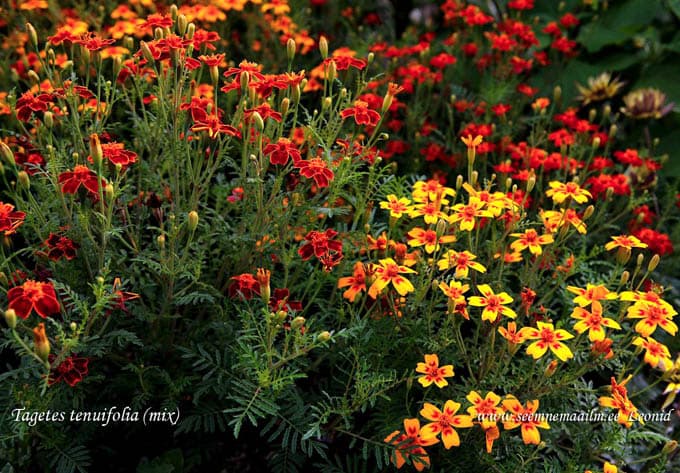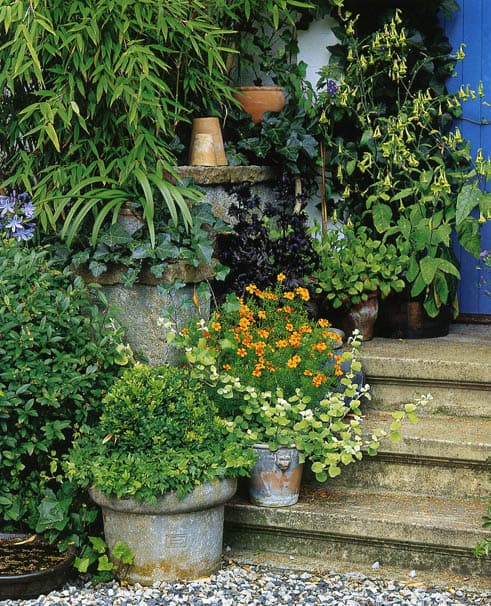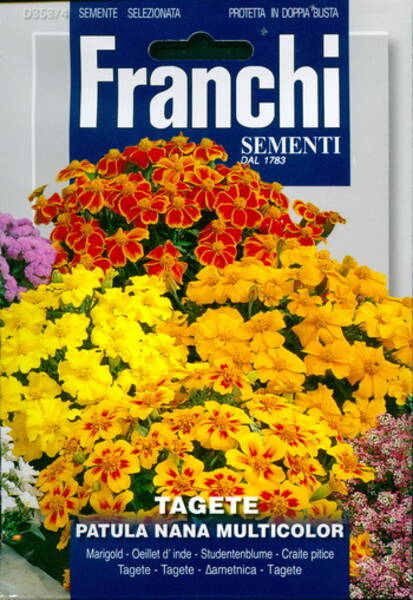Dense and compact bushes absolutely covered with an incredible amount of miniature inflorescences!
A magnificent curb plant that blooms continuously throughout the season. A graceful spherical bush, strongly branched, about 30 cm high.
Inflorescences are non-double, about 2 cm in diameter, multi-colored, two-colored.
Used for framing flower beds, borders, in mixborders and for decorating balconies.
1,0 g = 650-700 seeds.


Signet Marigold, slender-leaf marigold, striped Mexican marigold.
Location: do not require intense sunlight, although they achieve maximum decorativeness in sunny places. They do not tolerate spring and autumn frosts well.
Soil: require nutritious, well-moistened soils in the first half of summer.
Care: considered drought-resistant, but at the beginning of growth they need watering, otherwise the plants will be puny, and the inflorescences - small.
Marigolds react negatively to excess moisture in the soil. In rainy weather, their inflorescences begin to rot.
And if the soil is oversaturated with water, the plants begin to die from fungal diseases of the roots.
Spring fertilization entails strong growth and delayed flowering.
Diseases and pests: inflorescences often rot during prolonged rains.
In dry, hot conditions, marigolds are affected by spider mites.
To get rid of it on plants, you must first increase the air humidity by spraying the seedlings with water several times a day.
For complete destruction, use 2-3-fold spraying with infusions of onions, hot red pepper, yarrow.
Reproduction: by seeds. Marigolds can be sown in open ground in late May - early June. Shoots appear 5-10 days after sowing.
It is advisable to cover the soil with non-woven material (agrotextile). In this case, you can sow a week or a week and a half earlier than usual and thereby speed up flowering.
Marigold seedlings are easy to grow indoors on a bright window, and even better in film greenhouses, where the plants will be the strongest.
For healthy seedlings, you need loose, nutritious soil, an even temperature of +18+22°C and moderate watering (rejected marigolds are less demanding on soil and temperature).
Although marigold seedlings are considered unpretentious, it is better to take fresh soil for sowing.
Seedlings can be grown in a box, bowl or pot. Drainage (crushed stone, expanded clay, coarse sand) should be poured on the bottom in a 3 cm layer or holes should be made.
Otherwise, the plants may die from fungal diseases. First, 2/3 of the soil is poured onto the drainage, and this layer is compacted by hand or with a rammer.
The next layer should be loose so that the sprouting roots have enough air.
The soil should not reach the edge of the container by 1-2 cm. The prepared soil is watered well and left for one or two days in a warm place so that it "breathes".
Marigold seeds are large, so they can be carefully laid out in furrows at a distance of 1-1.5 cm. The distance between the furrows themselves is 1.5-2 cm.
Thickened seedlings suffer more from a lack of light and stretch out. They can even get sick with "black leg".
The easiest way to get optimal density is by sowing sprouted seeds.
To germinate, they need to be laid out on a damp cloth on a saucer and, putting them in a plastic bag, put them in a warm place. After 2-3 days, the seeds will hatch.
The laid out seeds are covered with a layer of soil 0.5-1 cm. Loosely covered seeds can die from drying out. If the seeds are buried in the soil too deeply, they may not sprout at all.
After sowing, the top layer of soil is carefully watered, then covered with paper. The containers are placed in a warm place (+22+25°C) and the soil moisture is carefully monitored.
After 3-7 days, sprouts will appear and the containers should be moved to a bright place at a lower temperature (+18+20°C). If the seedlings are still dense, they need to be picked.
The seedlings are carefully removed from well-watered soil and planted in a hole, deepening them to the cotyledons. This will promote the formation of new roots.
Good seedlings have 2-3 pairs of leaves and a strong root system by the time of planting. Seedlings are planted in the ground in late May - early June.
Plants are planted in the soil 1-2 cm deeper than they grew before. The distance between plants depends on the species and variety. Tall hybrids and varieties of marigolds are planted according to the scheme 40 x 40 cm, medium varieties and F1 hybrids - 30 x 30 cm and low varieties and hybrids of all types - 20 x 20 cm. Transplantation is easily tolerated at any age, even in a flowering state.












